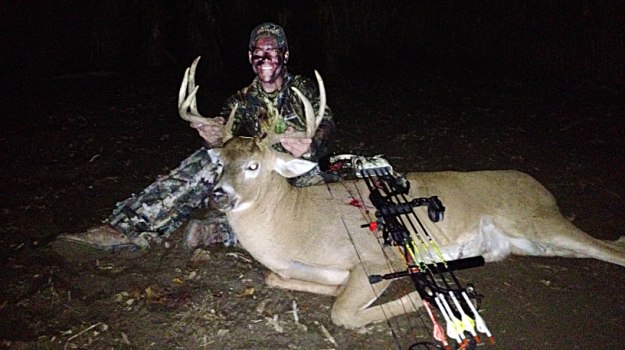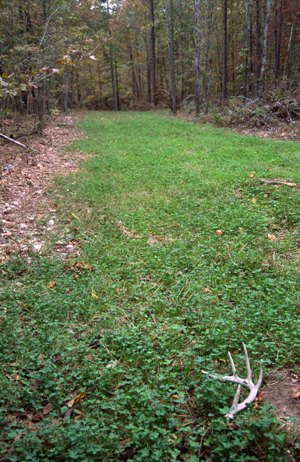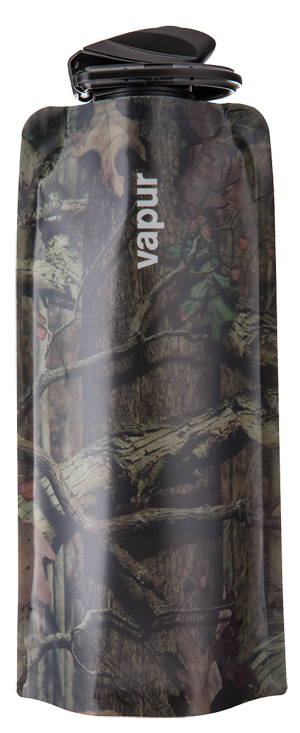
Editor’s Note: Kyle Meyer from Milan, Michigan, has been a Mossy Oak pro for the last 5 years. “I became a pro when I was 19, and I'm 24 now,” Meyer says. Like many of us, Meyer went with his dad deer hunting when he was about 4-years old and started hunting on his own when he was 12, the age at which he could hunt with a bow in Michigan. He’d rather hunt with a bow, but he also hunts with a gun in his home state, one of the top three states for numbers of deer hunters in the U.S. Although Meyer has 6,000 acres of private land to hunt, that only includes about 200 acres of woodlots. According to Meyer, “My favorite Mossy Oak pattern is Treestand, because most of the time, I'm hunting from a tree stand. When I'm in a ground blind, from the waist up, I’ll wear a solid black shirt, gloves and face paint and my Treestand pants. I also wear Mossy Oak Infinity for turkey season, and I like Mossy Oak Bottomland.”
This 3-year-old buck that was living right behind my house - only about 500 yards from my back door – was what we called a management buck. He didn’t appear to have the potential to be more than a 7-pointer, but I named him the Super Seven. The buck was living in a 15-acre woodlot, surrounded by crop lands, with a river bottom coming out of it that meandered into another 20-acre woodlot.
On this day, my dad was running the combine off to my right, cutting and shelling off corn. I decided to take a stand in-between the two woodlots and climbed into the stand at noon. I wasn’t seeing anything, and my phone started vibrating. When I answered, my dad told me, “Kyle, deer are running all over the place out here in this corn field.” I stayed in my stand. My dad shut down the combine about an hour before dark. Then 30 minutes before dark, I heard an animal coming through the corn right toward me. When I saw him, I immediately knew he was the Super Seven Buck.
 I’d planted a small Mossy Oak BioLogic food plot close to my stand in the corner of the woods to improve my green field. I’d used a mini-excavator to dig a water hole to give the deer green food and water right on the edge of the corn. I watched the Super Seven Buck make a scrape on the edge of my green field, but I couldn’t take the shot, since the buck was behind a tree. However, I didn’t panic because I thought the buck would walk down the edge of the woods and give me a 20-yard broadside shot. And sure enough, that was what happened.
I’d planted a small Mossy Oak BioLogic food plot close to my stand in the corner of the woods to improve my green field. I’d used a mini-excavator to dig a water hole to give the deer green food and water right on the edge of the corn. I watched the Super Seven Buck make a scrape on the edge of my green field, but I couldn’t take the shot, since the buck was behind a tree. However, I didn’t panic because I thought the buck would walk down the edge of the woods and give me a 20-yard broadside shot. And sure enough, that was what happened.
I put my 20-yard pin on the buck and squeezed the trigger on my mechanical release. But to my surprise, the buck made two hops and looked back at me. I couldn’t believe my eyes. I felt I’d made a good shot. Yet, this buck didn’t look like he’d been hit at all. With the Super Seven about 40 yards away, I nocked a second arrow. Then Super Seven wobbled back and forth before falling over. I walked up to the house to get my mom, because she likes to take pictures of the deer my dad and I take. I told my dad, “There won’t be any tracking of this buck, because I watched him tip over.”
Although I live and work on a family farm with plenty of corn and soybeans for the deer to eat, I’ve learned that the deer still like to eat green food in the fall and winter months and of course need water to drink. By creating small green fields and digging watering holes on the edges of agricultural fields, I can provide the food and the water deer are looking for at the time of year when there’s no green food left. If you're hunting deer in an agricultural area and want to get bucks in close enough to take them with a bow, you may want to consider planting some small green fields with water holes next to them to stop those bucks going to and from those agricultural fields. At least this practice works for me.
To learn more about hunting, check out John E. Phillips’ new eBook and print book, “Bowhunting Deer: Mossy Oak Pros Know Bucks and Bows.” You also can download a free Kindle app that enables you to read the book on your iPad, computer or Smartphone.
For information on making jerky from your deer to provide a protein-rich snack, you can download a free book from http://johninthewild.com/free-books.
Day 2: Kyle Meyer Crawls to the Texarkana Buck
Tomorrow: Kyle Meyer’s First Buck with a Bow



























